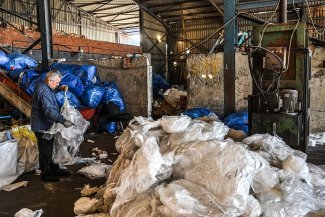
Lake Kapchagay, an artificial lake in southern Kazakhstan, is a popular destination for local tourists. In addition to a large dam, this small town is now home to an energy-intensive bitcoin mining farm.
At a cost of only US$0.04 a kWh, electricity rates in Kazakhstan are among the cheapest in the world. The promise of saving on energy costs is attracting more and more cryptocurrency mining companies, whose energy-intensive activities leave a large carbon footprint. French companies like BigBlock Datacenter, which failed to sustain its business in Ukraine due to political instability and rising electricity costs, are now betting on Kazakhstan.
Over the last several months, the largest country in Central Asia has become a stable and attractive environment for data centres thanks to its cheap electricity and ‘crypto-friendly’ policies. Moreover, there is no risk of supply interruptions since Kazakhstan’s power stations can produce more energy than its population and current industries require.
“With renewable electricity such as hydroelectricity, there’s production capacity that isn’t necessarily resold. The dam depends on the driving force of water, which can sometimes overwhelm demand,” explains Sébastien Gouspillou, co-founder and CEO of BigBlock Datacenter. The company’s facility in Kapchagay will be able to use up to 45 megawatts to generate bitcoins, the best known of the 1500 currently listed cryptocurrencies, for its foreign clients.
According to Gouspillou, his company works with renewable energy and can provide Kazakhstan with both jobs and, as a customer, electricity consumption that is “completely linear, 24 hours a day, seven days a week, all year round.”
On the company’s official website, he claims that this will mean more profits for Kazakh producers as his business activities make him “a buyer of last resort for the supply of electricity” and thus an “important actor” in global energy transition.
He’s not the only one to see such advantages. “Economically, Kazakhstan is, like any other country, interested in using its surplus energy,” says Madi Saken, a specialist with the Data Centre Industry and Blockchain Association of Kazakhstan.
French blockchain calculation professionals view Kazakhstan as an attractive source of renewable energy. Yet in February 2020, the Ministry of Energy estimated that only 2.3 per cent of all energy produced in Kazakhstan comes from renewable sources. People in the country still heat their homes with energy that comes mostly from fossil fuels. Choice in the electricity market doesn’t exist for the ordinary urban population.
Meanwhile, the miners of BigBlock are already looking far into the future, announcing plans to settle in Tajikistan, the poorest country in Central Asia.
Greenhouse gas emissions and other risks
Cryptocurrency farms are major consumers of energy. Their data centres contain thousands of processors that operate day and night performing increasingly complex calculations. The more calculations they make and the faster they do it, the more that holders of cryptocurrencies earn. This makes the industry’s carbon footprint a cause for concern.
In 2018, researchers at the Technical University of Munich estimated the bitcoin industry’s annual global carbon emissions from its electricity consumption to be 22 megatonnes of CO₂. They also found roughly 68 per cent of this computing power to be located in Asia, versus only 17 per cent in Europe.
According to Greenpeace Russia, “the waste of energy by the bitcoin industry is becoming an even more serious problem because many of their mining facilities are located in regions where energy is largely produced from coal.”
Data centres also generate heat. “The servers warm up and they warm up their surroundings, so they need to be cooled down,” says Timur Yeleussizov, a local environmental activist. Additional energy is required to cool down the equipment.
At present, there are no official figures on greenhouse gas emissions produced by the cryptocurrency industry in Kazakhstan. “Naturally there are bigger factors contributing to climate change. However, the carbon footprint is big enough to make it worth discussing the possibility of regulating cryptocurrency mining in regions where power generation is especially carbon-intensive,” explains Christian Stoll, head of the German research team, on the university’s website.
While some international miners claim to be using “100 per cent green energy,” Yeleussizov is not convinced that their activities are harmless. With water levels in Kazakhstan’s rivers and lakes falling, the activist warns that the country is at risk of a water crisis, a major ecological problem that can be exacerbated by the use of large hydroelectric dams.
Oluwaseun Fadeyi, a researcher affiliated with the University of Hradec Králové in the Czech Republic who works on issues related to the environment and the climate crisis, criticizes the encouragement of activities that contribute to our collective carbon footprint. Even if miners use hydropower, “it is not completely safe if there is no effective monitoring by special government agencies. Absent government regulations you can’t completely believe what the miners say”.
Towards a new Kazakhstan of data centres
Even if BigBlock Datacenter shows a willingness to use only energy from renewable sources, there is no guarantee that other miners will do the same. According to Alan Dorjiyev, energy sector specialist and president of the Data Centre Industry and Blockchain Association of Kazakhstan, most cryptocurrency miners in Kazakhstan are based in industrial regions, such as Karaganda and Oskemen, where coal and non-ferrous metal mining continues to be a major part of the local economy. The electricity supplied there comes partly from coal-fired power plants.
People living near heavy industries already suffer from air pollution and health problems. According to Alexandra Ossipova, a blogger from Oskemen, people in her city live in “an aggressive environment.” “You can feel the aftertaste of metal [in the air] when you walk around,” she says.
Today, residents of Oskemen don’t appear to be well informed about the presence of a mining farm in their area. Ossipova fears that even if they were, the danger posed by new technologies would seem minimal to them compared to that of large traditional factories. The local and national media are sorely lacking in information about cryptocurrency mining and its potential consequences.
According to Saken, the fact that Kazakhstan uses very little clean energy “is not a problem of the [cryptocurrency] mining market, it is a problem of the energy infrastructure. In that way you can criticize any business which somehow uses energy.”
Cryptocurrency specialists seem to have their vision of a better future. “If we replaced all the industries with the industry of data centres, everything would, in effect, become cleaner,” says Dorjiyev, who argues that emissions from cryptocurrency mining are undoubtedly lower than those from factories. According to him, since the coronavirus hit industries in the region, bitcoin miners in Oskemen have been saving jobs by buying part of the electricity previously consumed by the Ust-Kamenogorsk titanium and magnesium plant.
“With progressing digitalisation, there is a need for more and more data centres, which will seek out places with cheap [and ideally clean] electricity. However, traditional energy-intensive industries will not leave such places for the same reason,” says Stoll.
Roman Chestnykh, an environmental engineer living in Oskemen, believes that companies making a profit in a country with old energy infrastructure should “invest money in changes to the energy system, in modernisation: to make a transition to renewable sources or to finance gasification in regions.” But such a move seems unlikely for a country that is a major producer and exporter of oil and coal, which represent a significant portion of its GDP.
While Kazakhstan has ratified the Paris Agreement, committing to reducing its greenhouse gas emissions by 15 per cent by 2030 compared to 1990 levels, according to the Minister of Ecology, the country is presently not fulfilling its commitments. In 2018, global polluting emissions from the country’s power plants and industries increased by 100,000 tonnes.









